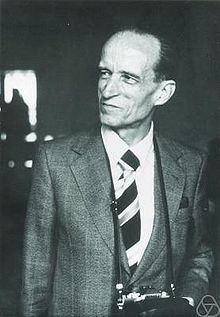Martin Eichler
German mathematician
Martin Eichler | |
|---|---|
 Martin Eichler | |
| Born | (1912-03-29)29 March 1912 |
| Died | 7 October 1992(1992-10-07) (aged 80) |
| Nationality | German |
| Scientific career | |
| Fields | Number theory and Mathematics |
Martin Maximilian Emil Eichler (29 March 1912 – 7 October 1992) was a German number theorist.
Eichler received his Ph.D. from the Martin Luther University of Halle-Wittenberg in 1936.
Eichler and Goro Shimura developed a method to construct elliptic curves from certain modular forms. The converse notion that every elliptic curve has a corresponding modular form would later be the key to the proof of Fermat's Last Theorem.[1][2]
Selected publications
- Quadratische Formen und orthogonale Gruppen, Springer 1952,[3] 1974
- Lectures on Modular Correspondences. Tata Institute. 1955; pbk, 169 pages
{{cite book}}: CS1 maint: postscript (link) - Einführung in die Theorie der algebraischen Zahlen und Funktionen, Birkhäuser 1963; Eng. trans. 1966, Introduction to the theory of algebraic numbers and functions, in which a section on modular forms is added; pbk 2014 reprint of 1963 German original
- Projective varieties and modular forms 1971 (Riemann–Roch theorem); Eichler, M. (15 November 2006). 2006 edition. ISBN 9783540368694.
- with Don Zagier: The Theory of Jacobi forms, Birkhäuser 1985; Eichler, Martin; Zagier, Don (14 December 2013). 2013 edition. ISBN 9781468491623.
- Über die Einheiten der Divisionsalgebren, Mathem. Annalen 1937[permanent dead link]
- Neuere Ergebnisse der Theorie der einfachen Algebren, Jahresbericht DMV 1937[permanent dead link]
- Allgemeine Integration linearer partieller Differentialgleichungen von elliptischem Typ bei zwei Grundvariablen, Abh. Math. Sem. Univ. Hamburg 15 (1947), 179–210. MR0029054
- On the differential equation uxx + uyy + N(x)u = 0, Trans. Amer. Math. Soc. 65 (1949), 259–278 doi:10.1090/S0002-9947-1949-0029055-8
- Zur Algebra der orthogonalen Gruppen Mathem. Zeitschrift 1950[permanent dead link]
- Zahlentheorie der Quaternionenalgebren, Crelle J. vol. 195, 1955, with errata [1]
- Quaternäre quadratische Formen und die Riemannsche Vermutung für die Kongruenz-Zetafunktion, Archiv Math. vol. 5, 1954, pp. 355–366 (Ramanujan–Petersson conjecture)
- Eine Verallgemeinerung der Abelschen Integrale, Math. Zeitschrift vol. 67, 1957, pp. 267-298[permanent dead link]
- Quadratische Formen und Modulfunktionen Acta Arithmetica vol. 4, 1958, pp. 217–239
- Eine Vorbereitung auf den Riemann-Rochschen Satz für algebraische Funktionenkörper, Crelle J. 1964
- Einige Anwendungen der Spurformel im Bereich der Modularkorrespondenzen[permanent dead link], Mathem. Annalen 1967, (Eichler–Shimura theory)
- Eichler Eine Spurformel von Korrespondenzen von algebraischen Funktionenkörpern mit sich selber, Inv. Math. vol. 2, 1967[permanent dead link] with corrections [2][permanent dead link]
- The basis problem for modular forms and the traces of the Hecke operators, Springer, Lecture notes Math. vol.320, 1973, pp. 75–152
See also
- Eichler–Shimura congruence relation
- Eichler–Shimura isomorphism
- Eichler cohomology
- Eichler order
- Eichler's proof of the CBH theorem
References
- ^ Richard Taylor (2012). "Modular Arithmetic: Driven by Inherent Beauty and Human Curiosity". Institute for Advanced Study. Retrieved 2014-12-22.
- ^ Edward Frenkel. Love and Math: The Heart of Hidden Reality. pp. 90. ISBN 978-0465050741.
- ^ Whaples, G. (1955). "Review: Quadratische Formen und orthogonale Gruppen by Martin Eichler". Bull. Amer. Math. Soc. 61: 589–593. doi:10.1090/S0002-9904-1955-10001-8.
External links
- O'Connor, John J.; Robertson, Edmund F., "Martin Eichler", MacTutor History of Mathematics Archive, University of St Andrews
- Martin Kneser, Martin Eichler (1912-1992), Acta Arithmetica vol. 65, 1993, pp. 293–296, Obituary (in German).
- Jürg Kramer, Leben und Werk von Martin Eichler, Elemente der Mathematik vol. 49, 1994, pp. 45–60.
- v
- t
- e












